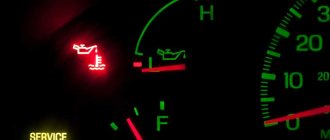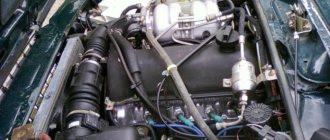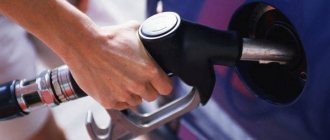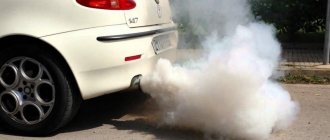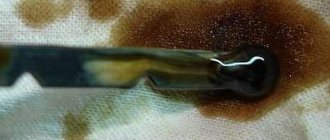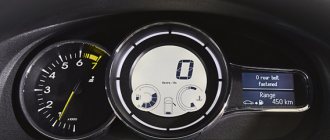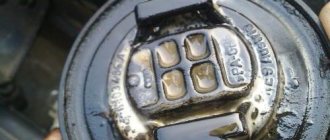Many car owners on forums ask the question: “Why does the engine oil smell like gasoline?” For most people, the smell belongs to the subjective category of sensations: for some it smells slightly like gasoline, for others it smells strongly. The perception of odor intensity is individual for everyone, and only specialists with the necessary equipment can make an objective assessment.
But the fact that the engine oil smelled like gasoline should not be ignored either. Fuel getting into the oil is only possible if there is a malfunction and can lead, at a minimum, to excessive consumption of fuel and oil and, at a maximum, to engine failure.
How does gasoline end up in oil?
This point is not completely clear, but experts believe that there are two ways:
- Through the main fuel pump. The lower part of the pump diaphragm protects the upper part from harmful crankcase gas vapors. If the upper layers break through, the pump prevents gasoline from ending up in the crankcase itself. To prevent such an unpleasant event from happening, it is recommended to periodically check the position of the diaphragms and their condition.
- Through the carburetor. This can happen if the device has a poor quality needle valve in the float chamber. In this situation, the car will function under wear and tear, which will lead to large excess fuel consumption. If gasoline consumption is reduced, its volume in the float chamber will begin to increase. As a result, the carburetor may overflow. This process may be accompanied by excessive enrichment of the mixture. Symptoms of this phenomenon include dark exhaust or even a complete engine stop.
It also happens that the car owner is unaware that fuel has gotten into the oil. He will be able to find out about this when there is already an excess amount of gasoline in the oil. In this case, the emergency pressure light on the dashboard will light up.
Influence
People use gasoline for more than just affordable fuel. This substance is a key component of various solvents, varnishes and paints that are actively used in everyday life, so not only gas station workers are at risk, but also ordinary housewives and everyone around them.
The appearance of gasoline vapors occurs at average temperatures, while the substance accumulates in the lower layers of air and remains in the room for a long time. The symptoms of a poisoned person are often not dangerous to health. Those who have done painting work at least once know what effect the substance produces and how quickly it passes. However, in some cases, such an accumulation of vapors poses a great threat.
There are several ways for gasoline to enter the body:
Gasoline enters the lungs along with the air - if a person inhales substances containing gasoline, he will experience the corresponding symptoms. The substance can be absorbed through the skin and mucous membranes, causing damage to the integument.
It is possible that gasoline may get into the stomach, but this happens through negligence or during a suicide attempt in people with mental disorders.
Reasons for gasoline getting into oil
Poor quality fuel
One of the reasons why gasoline may end up in oil is the low quality of the fuel itself. Unfortunately, sometimes consumers are sold gasoline mixed with additives: toluene, benzene and others. They are inherently harmful and can quickly penetrate the crankcase with the oil element.
Oil exposed to poor quality fuel may lose its performance properties. As a result, the fuel distribution mechanism will fail. Therefore, drivers should be careful when choosing fuel.
Injector malfunction
Gasoline can get into the oil even if the injector does not close tightly. In this case, fuel leaks into the cylinder, and then directly into the oil composition through gaps in the piston.
The occurrence of such an effect can be determined by the pressure in the distribution system. Its value is measured using a pressure gauge with a high pressure hose and an adapter for connecting to the fuel rail.
The adapter is connected to the ramp, and the pressure gauge is connected to the adapter. After this the ignition is turned on. After the fuel pump starts working, you will need to wait until the pressure in the rail becomes normal. Next, you will need to turn off the ignition.
If the fuel pump does not start when the ignition is turned on, you need to start the engine and make sure that the pressure rises to normal. After this, you can turn off the ignition and turn off the engine.
After this, you will need to observe the readings of the monometer for 5-10 seconds. If its needle drops to the bottom by more than a third, then a leak probably occurred in the fuel supply system. After this, you will need to remove the fuel rail with injectors and place it in a place accessible for inspection.
Each of the nozzles will need to be placed in a transparent container. In this case, it is worth connecting the gas line and electrical connections. After this you will need to turn the ignition back on. After the pressure in the power system becomes normal, you will need to turn off the ignition and monitor each of the injectors for fuel leaks.
Damage to the piston system
If the oil smells like gasoline, then the reason for this may be a faulty piston system. Restoring this system is expensive and complex. If the driver uses low-quality fuel or lubricant, carbon deposits may form on the pistons, and the piston rings may become coked.
In other words, we can say that the grooves in which the rings are located become clogged with soot, as a result of which the elasticity of the rings disappears. A gap forms between the walls of the piston and cylinder, through which some of the fuel may be lost.
If the piston has lost its tightness, this can be identified very easily. You will need to unscrew the candle and plug the hole with a paper plug. Next you will need to crank the engine with the starter. If the plug flies off, it means there is compression.
The presence of coking can be determined using a compressometer. This device is a pressure gauge that is installed on a special tube with a check valve and a rubber tip. It is better to check with a partner.
On carburetor engines you will need to remove the spark plugs. After this, you will need to attach a compression gauge to any cylinder and turn the engine with the starter until the arrow completes its movement in the direction of increasing readings.
The resulting value will indicate the compression of the cylinder. This operation is repeated on each of the cylinders. If the values differ by more than 10 percent from those set by the manufacturer, the motorist will need to think about troubleshooting. You can eliminate coking in the engine using a special fluid. When using it, you should follow the manufacturer's recommendations. Once the problem is resolved, the oil will need to be changed.
Checking and repairing a mechanical fuel pump at home
It is advisable to begin any repair work on the engine by washing and cleaning dirt and dust at least at the repair site. The fuel pump must be removed by unscrewing the two mounting bolts. It is better not to disconnect the inlet and outlet gas pipelines if they do not interfere with dismantling. Otherwise, they can be disconnected by plugging the incoming fuel line with a plug of the appropriate size, otherwise fuel will leak from it.
After removal, put the fuel lines onto the fittings and secure them with clamps. The outgoing gas line must be clamped with a clamp if it is rubber. If the tube is metal, disconnect it from the carburetor and plug it tightly with a suitable plug. Then try to pump gasoline into the engine using the manual pumping lever. If on the side adjacent to the engine housing there are streaks of gasoline in the oil or a clearly and sharply distinct smell of fuel appears, it means that the fuel pump diaphragm is not sealed.
Further actions are possible in two options: replace the fuel pump with a similar new one or repair the existing one. When repairing an already installed device, you must purchase a repair kit for the device model being repaired. As a temporary option, you can add a couple of layers of cellophane to the diaphragm, but this will not last long. Disassembly and assembly of the fuel pump must be carried out in accordance with the vehicle manual.
If you have a set of spare parts for repair, it is advisable to replace all existing parts, especially the intake and exhaust valves and their springs. Wash the filter mesh thoroughly in clean gasoline or solvent. After assembly, it is advisable to check the functionality of the device and the tightness of the diaphragm. Checking this part is described above.
You can check its functionality by disconnecting the outgoing gas line from the carburetor or pump and pumping it with a lever. A full stream of fuel should splash out of the hose or fitting with each press. After completing all repair work, you need to more carefully monitor the oil, its level and color for some time during operation to be completely sure that the problem has been eliminated.
How can you tell if gasoline has gotten into the oil?
This can be done quite simply. You just need to take a dipstick with a layer of oil and bring it to the candle flame. It is important to follow safety precautions. If the oil is clean and does not contain gasoline, then it will not burn.
There are a number of other symptoms that may indicate something is wrong:
- High gas consumption. Fuel begins to be consumed in large quantities due to the fact that it partially leaks into the crankcase.
- Knocking in the piston, presence of loud noises. This symptom rather indicates a malfunction in the fuel processing system.
- Reduced engine power. The car will not be able to drive up the mountain.
- High level of lubricant in the sump near the engine and discoloration.
- Reduced coolant level.
If you detect at least one of these signs, you should visit a car service center.
And for older children - Water Park "Banana Republic"
Why does engine oil turn black and is it dangerous?
The presented water park is located on the outskirts of Evpatoria, namely in the village of Pribrezhnoye, which is located on the seashore. As for Crimea, the creators of this water park are confident that vacationers will not find a larger water park. It has many slides that have different heights, a cafe and much more. This water park contains the best entertainment for children in Evpatoria, so not only children, but also their parents will have something to do.
In the water park "Banana Republic", Crimea
Disadvantages: But, like everywhere else, there are also some disadvantages. There are both new slides installed here, as well as old ones that do not look entirely reliable. If you get there during peak season, you will have to stand in line for about 30 minutes. Food in the canteen is expensive. Big conflicts arise around black VIP bracelets, thanks to which you can ride the coaster without having to stand in line.
- Their portal:
- Working hours are from 10 am to 6 pm.
- The price of entrance tickets is around 600-1400 rubles.
- VIP ticket costs 3,000 rubles;
- a child under 90 cm is admitted free of charge.
You can get to the water park presented by a commuter bus, which will take you to the city of Saki. Although, it is easier to get there by buses provided by the water park itself (travel on them is free). They travel according to a schedule, their route goes from the city of Evpatoria, then Zaozerny, Mirny, etc., and there is also a route from the city of Saki.
All details of this schedule can be found on the portal of the Banana Republic water park. Only when the hot season comes, traveling on these buses is very stuffy due to the fact that they do not have air conditioning; they are always crowded, so some have to stand the whole way.
You can also go to the museum
Evpatoria has a rich ancient history, which means that here you can not only treat your health, but also spend your free time with benefit and interest. Schoolchildren like to visit the museum that was opened here not so long ago - “Pirates of the Black Sea”. This museum can easily be classified as one of the best entertainments in Evpatoria for children!
Consequences of gasoline getting into oil
Because gasoline is an aggressive chemical substance, it causes negative reactions, which at some point can lead to malfunctions. Much depends on how much gasoline has managed to get into the oil. If its volume is small, then the engine can still run for some time. But this still will not prevent malfunctions from occurring. If the gasoline that gets into the lubricant has a fairly large volume, this can lead to breakdown of some mechanisms.
Here are some consequences:
- Violation of the fuel correction coefficient, as a result of which the engine will periodically stop.
- Reduced driving speed. It will be increasingly difficult for the car to show all its power.
- The appearance of breakdowns in the piston system.
- The appearance of faults in the engine.
These are the consequences that are most common. Fortunately, they don't happen that often. But still, this does not mean that we can turn a blind eye to this problem. It is important to contact a car service in a timely manner. Otherwise, a gasoline leak can lead to lengthy and costly car repairs.
Poor quality fuel
Sometimes the cause of incomplete combustion of the fuel mixture in the cylinders is the gasoline itself. It is not uncommon that the quality of fuel at gas stations leaves much to be desired. Moreover, gasoline may be mixed with other additives that make it more difficult to ignite. Unburned fuel mixture residues penetrate into the engine crankcase. In these cases, to fix the problem, you need to start using another gas station, but you will still have to change the oil.
Some experts advise, as a preventative measure, when driving on open roads, to allow the engine to run for a short time at high speeds. This type of driving leads to higher oil temperatures. This reduces the amount of condensate accumulated in the lubricant and gasoline entering the oil.
5) After the car has been cleaned and dried, check to see if any foreign odors have been eliminated
If, after thoroughly cleaning the car interior, the foreign odor remains, then it’s time to find the source of the smell. Here are some tips to help you find the cause of the smell.
As a rule, an unpleasant odor is caused by bacteria that are formed due to some kind of debris. There may be leftover food somewhere in the car. Also, foreign odor is often formed due to the remains of shoe soles (heels, etc.). In order to find the source of the smell, carefully look again at all places in the car that may contain dirt.
Often the cause of an unpleasant odor is ingrained cigarette smoke. Just one smoked cigarette inside the car can leave an unpleasant odor in the car for a long time, which is very difficult to remove, even with the help of special cleaning products.
To eliminate the smell of cigarettes, place a waffle towel in an iron bowl and pour white distilled vinegar into it, placing the bowl in the car next to the ashtray. Also, if the rear passengers smoked in the car, place the same bowl of vinegar in the back of the car. The vinegar solution and towel will absorb the foreign smell of tobacco for several hours.
Also, to eliminate the smell of smoke in a car, you can dilute water with baking soda, pour the solution into any container with a spray bottle, and treat the car interior with it, after which, without wiping the interior surfaces, close the car for several hours.
If you constantly smoke in your car, then, unfortunately, the only way to eliminate the smell of smoke in your car is to not smoke in the car.
If there was a fire in your car for some reason, then the smell of burning was probably strongly ingrained in the materials of the car's interior. To eliminate this smell, you can try the vinegar method described above. If this does not help, then you need to go to a specialized car wash that uses high-quality, expensive cleaning products.
A common cause of unpleasant odor in the car interior is mold, which has formed due to the ingress of water or food debris. Most often, mold forms under rugs where moisture can get trapped, especially in rainy or snowy weather. To clean floor mats, use special carpet cleaners. Also, in order to avoid the formation of mold, it is necessary to dry the rugs from moisture.
If milk has been spilled in your car, you should not delay cleaning, as this can become a source of unpleasant odor that is difficult to remove. To clean seats from milk, it is necessary to remove as much milk as possible from the surface and rinse with water, and then thoroughly dry the surface.
Signs of a Leak
Is it possible to understand that there is a leak? You can find out about this by noticing a dark puddle under the car. It happens that lubricant leaks from under the valve cover lining, oil seals or crankcase gasket. Motor oil can only be mixed with fuel in the engine. It is possible to determine that gasoline has entered the oil liquid by the following signs:
- the viscosity of the oil changed, it became thinner;
- the car oil on the dipstick lights up if you bring the flame close to it;
- A drop of oil on a piece of paper leaves a greasy, growing stain.
